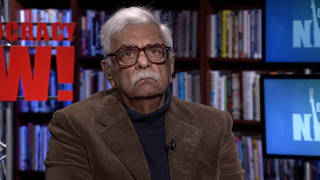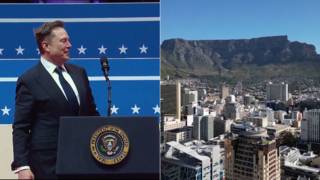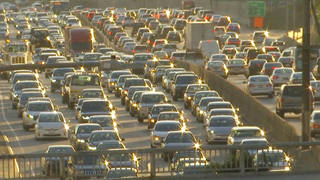
Related
Topics
Guests
- Linda Kropchief counsel for the Environmental Defense Center, based in Santa Barbara, California.
- Tyler Haydennews editor and reporter with The Santa Barbara Independent.
A cleanup effort residents say was slow to start is now underway off the coast of Santa Barbara, California, where crude oil from a broken pipeline leaked into the Pacific Ocean and washed ashore at Refugio State Beach. The company that operates the pipeline first said 21,000 gallons had leaked, but then increased their estimate to 105,000 gallons. On Thursday, The Santa Barbara Independent revealed the ruptured pipeline operated by Plains All American is the only pipeline in the county that is not required to be equipped with an automatic shutdown valve in case of a leak, because it operates outside of the regulatory oversight of the county. This latest spill recalls a catastrophic blowout at an oil well in the same area in 1969, when Union Oil’s drilling platform spewed an estimated three million gallons of crude along 30 miles of coastline. We speak to Tyler Hayden of The Santa Barbara Independent and Linda Krop of the Environmental Defense Center.
Transcript
JUAN GONZÁLEZ: A cleanup effort residents say was slow to start is now underway off the coast of Santa Barbara, California, where crude oil from a broken pipeline leaked into the Pacific Ocean and washed ashore at Refugio State Beach. The company that operates the pipeline first said 21,000 gallons had leaked, but then increased their estimate to 105,000 gallons. This is Michelle Rogow, on-scene coordinator for the Environmental Protection Agency, speaking Thursday.
MICHELLE ROGOW: Last night, crews worked with archaeological support and monitoring to excavate more than 400 yards of saturated—oil-saturated soil, starting at the far end south of the contaminated area in the actual release location. Air monitoring is being conducted in that area for both volatiles as well as for hydrogen sulfide. And this morning, crews are moving down toward the highway from the source area and continuing to excavate contaminated soil, beginning to flush out the actual culvert, the drainage pathway that led from the upland side of the highway down to the ocean, and are working to capture that oil and collect it.
AMY GOODMAN: On Thursday, The Santa Barbara Independent revealed the ruptured pipeline, operated by Plains All American, is the only pipeline in the county that’s not required to be equipped with an automatic shutdown valve in case of a leak, because it operates outside the regulatory oversight of the county. This latest spill recalls a catastrophic blowout at an oil well in the same area in 1969, when Union Oil’s drilling platform spewed an estimated three million gallons of crude along 30 miles of coastline.
Well, for more, we go directly to Santa Barbara, California, where we’re joined by two guests. Tyler Hayden is with us, news editor and reporter with The Santa Barbara Independent, and Linda Krop, chief counsel for the Environmental Defense Center.
We welcome you both to Democracy Now! Linda Krop, let’s start with you. Just explain the extent of the damage and what’s being done about it.
LINDA KROP: The spill has had a devastating effect already, and it’s very frustrating. I was at the site the first evening, and nothing was being done to prevent the oil from getting into the ocean, which should have been done immediately because the spill actually occurred about a quarter mile from the ocean. So when we got there Tuesday evening, the beach was just blanketed with a solid array of oil. The high tide was coming in. The waves were washing the oil out to sea, which makes it virtually impossible to clean up. They had no shore-based response. They had no offshore response. They had identified and contained the leak, but they had done nothing to prevent the oil from getting into the ocean. And now we have dead sea life. Birds, a sea lion have been oiled. And who knows how much the damage will be? But it’s already spread several miles towards Goleta and Santa Barbara.
JUAN GONZÁLEZ: And, Linda Krop, of course, for the residents in your area, that brings to mind the terrible tragedy that perhaps many of our younger audience don’t know about or weren’t born when it occurred, the 1969 spill there. Could you talk about that?
LINDA KROP: Yes, the 1969 spill occurred from an offshore platform blowout. And after that spill occurred, everyone thought that that was the end to offshore oil drilling in our area, and that’s not the case. The federal government did continue to approve more platforms off of our coast going into the 1980s. But one of the good results from the 1969 oil spill was that that is when most of our federal environmental laws were passed, in the early 1970s. And we have a lot more laws on the books. We have a lot more regulations. We have much more advanced technology. And yet, you still have oil spills happening all over the place. And what this shows us is it doesn’t matter how strong the regulations, how advanced the technology is, oil spills are inevitable. And the only way to stop oil spills is to stop oil development. This pipeline was not an isolated incident. This pipeline was carrying oil from our offshore platforms, and if those oil platforms weren’t there, the pipeline wouldn’t be there, and our beaches would not be fouled.
AMY GOODMAN: Tyler Hayden, can you talk about the company involved? Plains All American Pipeline has well over a hundred, nearly 200, violations around it over the last years. Talk about its record and how the spill was discovered.
TYLER HAYDEN: Well, the spill first came to our attention at around noon on Tuesday, when we heard that county firefighters had responded to smell of gas in the area. And they quickly saw what was described to us as a small river of oil spilling into the ocean. They traced it back up to the underground pipeline operated by Plains All American Pipeline and saw that the underground pipe had ruptured and was spilling oil. And from then, that’s when the—that’s when at least the attention was brought to the—for the pipeline, if not—as Linda said, there wasn’t a lot of response.
And Plains, as you said, has a bit of a checkered past when it comes to—when it comes to its safety and the enforcement of its infrastructure. And from what I understand, there’s been about 175 incidents in the last 10 years involving Plains pipes. It’s in the business of transporting and storing crude, and has about 6,000 miles of pipeline across the country. And I know during those spills recently that they haven’t been fined much by the EPA. I think the largest fine they received was about $280,000. So, there’s definitely some heightened scrutiny after this incident, but it sounds like they’ve had some issues for quite a while.
JUAN GONZÁLEZ: And the issue of why there was not an automatic shutoff on this pipeline?
TYLER HAYDEN: Right. So, what we found out yesterday was this pipeline has been a bit of a regulatory mess. When it was installed in 1987, Plains successfully sued the county to have the pipeline not be under the county’s management or jurisdiction. They argued that because it crosses state lines, that it should be under federal regulations. It was until 2013, and the federal government said that we didn’t—you know, they didn’t have the personnel or the—excuse me, the equipment for just sort of the need to manage the pipeline, so they passed it back down to the state. And the state has been managing it since 2013. But because it wasn’t under the county’s management, it wasn’t required to have an automatic shutoff system, that should have been able to detect the leak and should have been able to shut it off much sooner.
AMY GOODMAN: At a Thursday morning news conference, a Plains All American oil company spokesperson, Patrick Hodgins, dodged questions about the company’s safety record.
PATRICK HODGINS: We’re required to fill out certain federal documents to report all incidents. We have a tolerance of zero tolerance for failure to report. We report all incidents, regardless of they’re required to be reported or not. So, that gives—we got to put it in context. We report all incidents, including all near misses, which do not have a negative impact. And the purpose of that is so that we can learn, so we don’t have an incident that does have a negative impact. So, again, I would like to put it into context. We report all incidents regardless if it’s required or not. And if you looked at the—over the years, the scrutiny and the requirement to report more and more incidents of lesser volume, where at one time it was five barrels, it’s now down to five gallons. But again, if it gets on the ground, we do require it to be reported.
REPORTER: But how do you rate your record?
PATRICK HODGINS: Again, our goal is to continue to improve. Our goal is zero. And so, we’re going to continue to improve. We’re not happy unless it’s zero. So that is our focus.
REPORTER: Are you happy?
AMY GOODMAN: Despite its spill record, Plains All American reportedly has plans to construct a pipeline in Arkansas, where an ExxonMobil pipeline that ruptured in 2013 spilled nearly 135,000 gallons of crude oil into a residential area. Linda Krop, are we talking about a plain all-American oil spill here? And what do you think needs to happen?
LINDA KROP: I think what needs to happen, most of all, is awareness that the technology will never be perfect. This pipeline should have shut down immediately, and it did not. But we also had an oil spill here from an offshore pipeline in 1997, where the pipeline did shut down immediately when a leak was detected, and an operator on the offshore platform turned the pipeline back on and overrode the shutdown system. So, unfortunately, whether it’s the technology or whether it’s operator error, there are always going to be oil spills. There is absolutely no way to prevent that. And this spill has already had a very significant impact in an area that is one of the most biologically rich on the planet. It’s referred to as the northern Galapagos. And we just have to stop this cycle. We have to protect these areas.
JUAN GONZÁLEZ: And, Tyler, the connection of oil giant Exxon to this oil?
TYLER HAYDEN: You know, I can’t speak to that. I know that the pipeline was servicing the Exxon refinery a little ways up the coast. But as I mentioned, Plains—it’s a pipeline owned and operated by Plains. I don’t know if Exxon has much, if any, involvement in this spill.
AMY GOODMAN: Who ends up paying, Linda Krop, for all of this, the cleanup? And do you have high hopes it will be cleaned up?
LINDA KROP: The first part of the question is easier to answer. Plains will have to pay for the cleanup, and they will probably be assessed some fines and maybe even some penalties, if there’s a demonstration of some neglect or wrongdoing. I am not confident that the spill will be cleaned up, because so much of the oil reached the ocean. On average, an ocean oil spill is only cleaned up about 15 percent or so. Even as of day three, they did not have enough equipment on the water, enough boom, because they said they were restricted by how many vessels they had out there. So they had maybe a half a mile of boom for a spill that was, you know, well over nine or 10 miles. So, we do not think that the oil is going to be cleaned up, and I think we’re going to see the impacts for quite some time.
JUAN GONZÁLEZ: And finally, the amazing citizen response, hundreds of people coming out onto the beaches to try to do what they could to clean up this mess?
LINDA KROP: The community response has been amazing. Everyone wants to help. Unfortunately, the agencies responsible for the cleanup are trying to divert people to other activities, because there are some health implications. You know, this oil contains toxic chemicals, so they’re worried about people inhaling the toxics. They’re worried about people coming into skin contact. They’re worried that people aren’t trained. So they’re diverting people to some websites to volunteer, and then you go to those websites, and it says, “No volunteers needed.” So, people are starting to get very frustrated. They really want to help. They’d like to be on the beach helping. And so far, there hasn’t really been an avenue for them. But yeah, the community is really up in arms. We’ve been contacted by a lot of businesses that don’t normally align with the environmental groups here, but they’re even saying, you know, “What can we do?” And they’re feeling the hit. The tourists aren’t coming. The recreational industries are suffering. So we’re already seeing that economic hit, as well.
AMY GOODMAN: Let’s end with one of the members of the cleanup crew who’s been helping to clean up the oil spill off the coast of Santa Barbara, California.
CYRUS CASTANEDA: We arrived today. There was one gentleman on the beach shoveling oil from the ocean into the buckets, and we decided to join him. And the next thing you know, a lot more of us came down here. It was really early in the morning, about 7:00 a.m. And so, we’ve been shoveling buckets ever since.
AMY GOODMAN: That’s Cyrus Castaneda. And we will continue to cover this story, of course. We want to thank our guests, Linda Krop, chief counsel for the Environmental Defense Center, based in Santa Barbara, as well as Tyler Hayden, news editor and reporter with The Santa Barbara Independent.
This is Democracy Now! When we come back, Buffy Sainte-Marie joins us live in studio. Stay with us.












Media Options